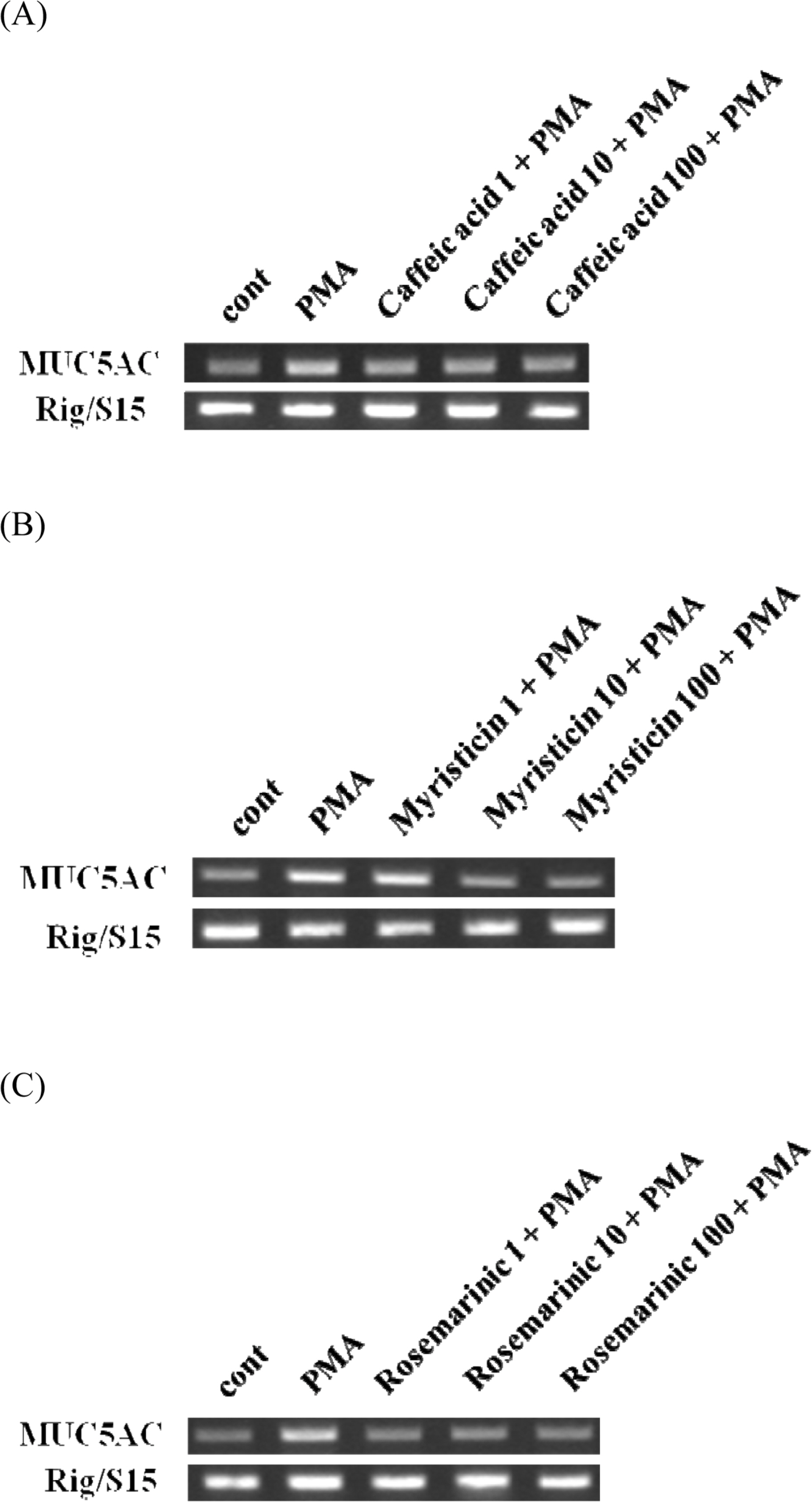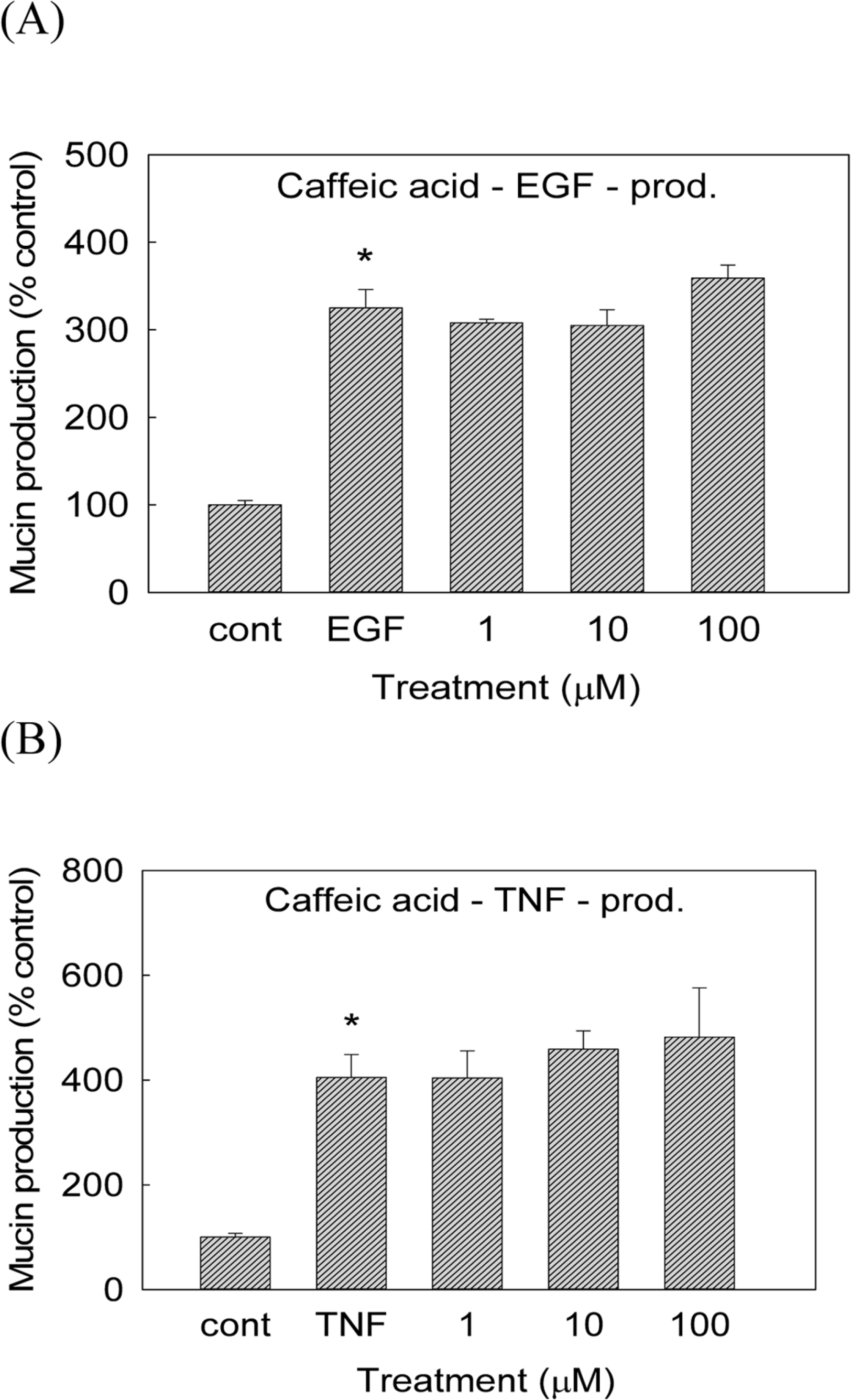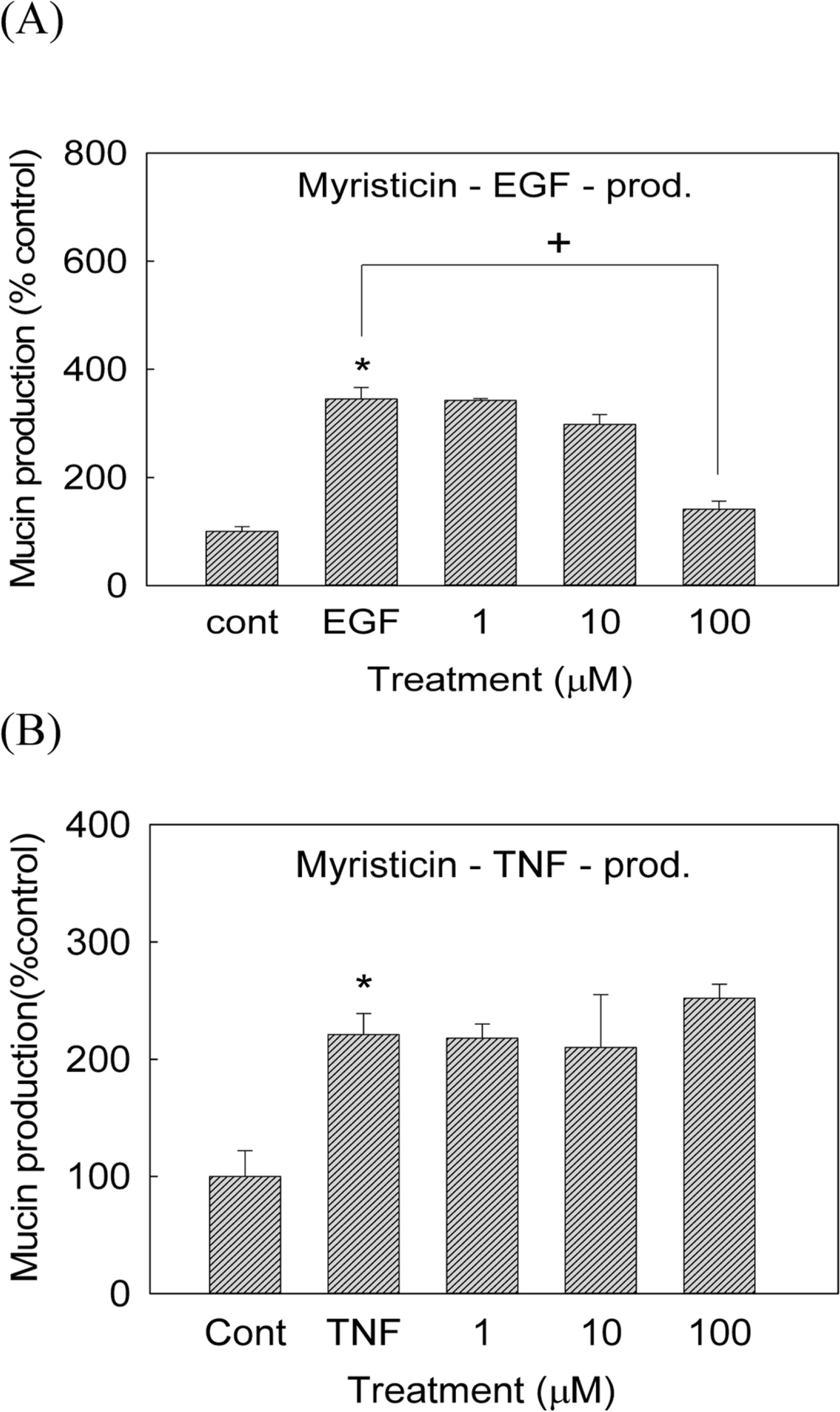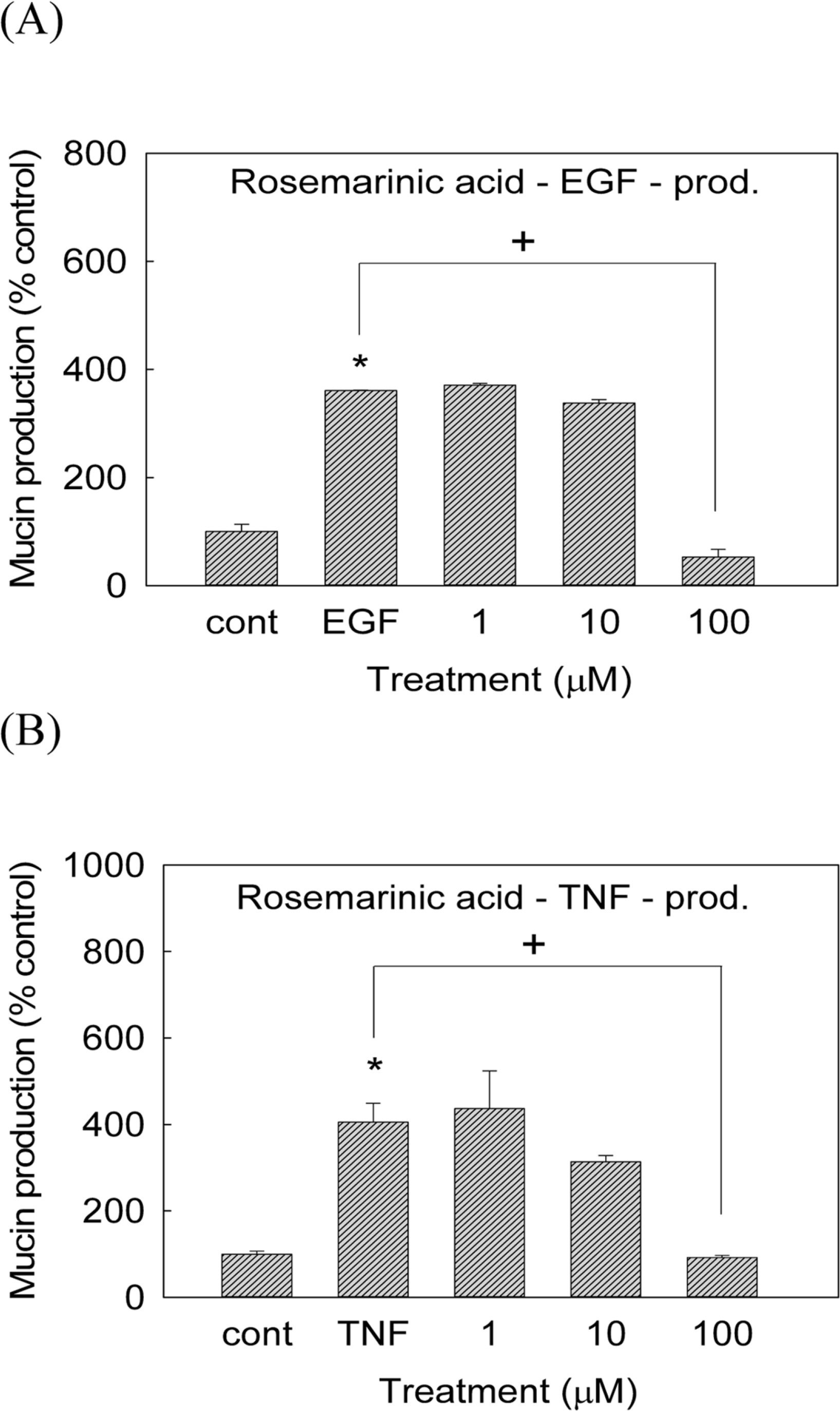Nat Prod Sci.
2016 Dec;22(4):275-281. 10.20307/nps.2016.22.4.275.
Effects of Caffeic Acid, Myristicin and Rosemarinic Acid on the Gene Expression and Production of Airway MUC5AC Mucin
- Affiliations
-
- 1Department of Health Management, Sahmyook University, Seoul, Korea.
- 2Natural Products Laboratory, School of Pharmacy, Sungkyunkwan University, Suwon, Korea.
- 3Department of Pharmacology, School of Medicine Chungnam National University, Daejeon, Korea. LCJ123@cnu.ac.kr
- KMID: 2366696
- DOI: http://doi.org/10.20307/nps.2016.22.4.275
Abstract
- Perilla frutescens was empirically used for controlling airway inflammatory diseases in folk medicine. We investigated whether caffeic acid, myristicin and rosemarinic acid derived from Perilla frutescens significantly affect the gene expression and production of mucin from airway epithelial cells. Confluent NCI-H292 cells were pretreated with caffeic acid, myristicin or rosemarinic acid for 30 min and then stimulated with phorbol 12-myristate 13-acetate (PMA) for 24 h. The MUC5AC mucin gene expression and production were measured by reverse transcription - polymerase chain reaction (RT-PCR) and enzyme-linked immunosorbent assay (ELISA), respectively. Additionally, we examined whether caffeic acid, myristicin or rosemarinic acid affects MUC5AC mucin production indued by epidermal growth factor (EGF) and tumor necrosis factor-α (TNF-α), the other two stimulators of production of airway mucin. The results were as follows: (1) Caffeic acid, myristicin and rosemarinic acid inhibited the gene expression and production of MUC5AC mucin induced by PMA from NCI-H292 cells, respectively; (2) Among the three compounds derived from Perilla frutescens, only rosemarinic acid inhibited the production of MUC5AC mucin induced by EGF or TNF-α, the other two stimulators of production of airway mucin. These results suggest that rosemarinic acid derived from Perilla frutescens can regulate the production and gene expression of mucin, by directly acting on airway epithelial cells and, at least in part, explains the traditional use of Perilla frutescens as remedies for diverse inflammatory pulmonary diseases.
Keyword
MeSH Terms
Figure
Reference
-
References
(1). Voynow J.A.; Rubin, B.K. Chest. 2009. 135:505–512.(2). Heo H. J.., Kim C.., Lee H. J.., Kim Y. S.., Kang S. S.., Seo U. K.., Kim Y. H.., Park Y. C.., Seok J. H.., Lee C. J.Phytother. Res. 2007. 21:462–465.(3). Heo H. J.., Lee S. Y.., Lee M. N.., Lee H. J.., Seok J. H.., Lee C. J.Phytother. Res. 2009. 23:1458–1461.(4). Lee H. J.., Lee S. Y.., Lee M. N.., Kim J. H.., Chang G.T.., Seok J. H.., Lee C. J.Phytother. Res. 2011. 25:1196–1200.(5). Jang I. M.Treatise on asian herbal medicines; Haksul-pyunsu-kwan in Research institute of natural products of Seoul National University: Korea,. 2003. , p. 2847.(6). Rocha J.., Eduardo-Figueira M.., Barateiro A.., Fernandes A.., Brites D.., Bronze R.., Duarte C. M.., Serra A. T.., Pinto R.., Freitas M.., Fernandes E.., Silva-Lima B.., Mota-Filipe H.., Sepodes B.Basic Clin. Pharmacol. Toxicol. 2015. 116:398–413.(7). Lee J. Y.., Park W.Molecules. 2011. 16:7132–7142.(8). Genaro-Mattos T. C.., Maurício Â. Q.., Rettori D.., Alonso A.., Hermes-Lima M.PLoS One. 2015. 10:e0129963.(9). Coelho V. R.., Vieira C. G.., de Souza L. P.., Moysés F.., Basso C.., Papke D. K.., Pires T. R.., Siqueira I. R.., Picada J. N.., Pereira P.Life Sci. 2015. 122:65–71.(10). Rogers D. F.., Barnes P. J.Ann. Med. 2006. 38:116–125.(11). Li J. D.., Dohrman A. F.., Gallup M.., Miyata S.., Gum J. R.., Kim Y. S.., Nadel J. A.., Prince A.., Basbaum C. B.Proc. Natl. Acad. Sci. USA. 1997. 94:967–972.(12). Takeyama K.., Dabbagh K.., Shim J. J.., Dao-Pick T.., Ueki I. F.., Nadel J. A. J.Immunol. 2000. 164:1546–1552.(13). Shao M. X.., Ueki I. F.., Nadel J. A.Proc. Natl. Acad. Sci. USA. 2003. 100:11618–11623.(14). Hong D. H.., Petrovics G.., Anderson W. B.., Forstner J.., Forstner G.Am. J. Physiol. 1999. 277:G1041–G1047. . Am. J. Physiol. 1999 277.(15). Hewson C. A.., Edbrooke M. R.., Johnston S. L. J.Mol. Biol. 2004. 344:683–695.(16). Park S. J.., Kang S. Y.., Kim N. S.., Kim H. M.Immunopharmacol. Immunotoxicol. 2002. 24:211–226.(17). Kim K. D.., Lee H. J.., Lim S. P.., Sikder A.., Lee S. Y.., Lee C. J.Phytother. Res. 2012. 26:1301–1307.(18). Fischer B. M.., Rochelle L. G.., Voynow J. A.., Akley N. J.., Adler K. B.Am. J. Respir. Cell Mol. Biol. 1999. 20:413–422.(19). Song K. S.., Lee W. J.., Chung K. C.., Koo J. S.., Yang E. J.., Choi J. Y.., Yoon J. H. J.Biol. Chem. 2003. 278:23243–23250.(20). Takeyama K.., Dabbagh K.., Lee H. M.., Agustí C.., Lausier J. A.., Ueki I. F.., Grattan K. M.., Nadel J. A.Proc. Natl. Acad. Sci. USA. 1999. 96:3081–3086.(21). Cohn L.., Whittaker L.., Niu N.., Homer R. J.Novartis. Found. Symp. 2002. 248:201–213.
- Full Text Links
- Actions
-
Cited
- CITED
-
- Close
- Share
- Similar articles
-
- Effects of Homogentisic Acid and Natural Products Derived from Pinellia ternata on Secretion, Production and Gene Expression of MUC5AC Mucin from Cultured Airway Epithelial Cells
- Effects of Cynaroside, Cynarin and Linarin on Secretion, Production and Gene Expression of Airway MUC5AC Mucin in NCI-H292 Cells
- Effects of Lobetyolin, Lobetyol and Methyl linoleate on Secretion, Production and Gene Expression of MUC5AC Mucin from Airway Epithelial Cells
- Effects of Nodakenin, Columbianadin, and Umbelliferone Isolated from the Roots of Angelica decursiva on the Gene Expression and Production of MUC5AC Mucin from Human Airway Epithelial NCI-H292 Cells
- Eriodictyol Inhibits the Production and Gene Expression of MUC5AC Mucin via the IκBα-NF-κB p65 Signaling Pathway in Airway Epithelial Cells







